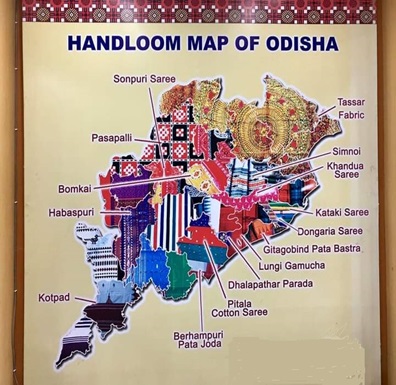Handloom Fabrics of Odisha GI Tagged
GI tagged Handloom fabrics of Odisha

Odisha has 24 GI registered products (as on 26.01.2024)
- GI Application No.-10 – Kotpad Handloom Fabric- Handicraft
- GI Application No.- 22 – Orissa Ikat – Handicraft
- GI Application No.- 136 – Khandua Saree and Fabrics – Handicraft
- GI Application No.167 – Gopalpur Tussar Fabrics – Handicraft
- GI Application No.207 – Dhalapathar Parda & Fabrics – Handicraft
- GI Application No.208 – Sambalpuri Bandha Saree & Fabrics – Handicraft
- GI Application No. 217 – Bomkai Saree & Fabrics – Handicraft
- GI Application No.219 – Habaspuri Saree & Fabrics – Handicraft
- GI Application No.220 – Berhampur Patta (Phoda Kumbha) Saree & Joda – Handicraft.
- GI Application No.541 – Dungaria Kondh Embroidery Shawl – Handicraft
The Orissa State Handloom Weavers Co-op. Society Ltd.,(BOYANIKA) (address: Pandit Jawaharlal Nehru Marg, Bhubaneswar – 751001, Orissa),
State level apex cooperative society was the initial applicant for these products.
Weavers producing these fabrics are required to apply and get registered as per procedure for using GI tags for their fabrics.
Kotpad handloom fabrics

- Originated from “Kotpad” village in Koraput district, Odisha.
- woven by weavers of the “Mirgan” tribal community.
- Unique feature – the vegetable dye of reddish color.
- yarn dyed with extract from bark of root of the “ Aal” tree.
- Represent the rich and fascinating story of a unique, timeless tribal textile tradition in Odisha.
- Original traditional weaving saree on pit looms in coarse cotton yarn,
- Motifs drawn from nature, common one’s crab, conch, boat, axes, fan, bow, temple, pots, snakes, palanquin bearers, and huts.
- weaving material and designs diversified to fine count cotton and silk
- Product diversified to shawls and stoles
- Registered as “Kotpad Handloom Fabric”- Handicraft
- Odisha’s first Geographical Indication (GI) sl no 8, application no.10, certificate date: 02.06.2005.
“Orissa Ikat” Bichitrapuri Saree

- Unique and one of the most popular handwoven traditional sarees, woven by the highly skilled weavers of Bargarh district, Odisha.
- Typical double Ikat both along warp and weft. Common design – geometric chess board (Pasapalli ) in the body
- Incorporates traditional touch , common motifs drawn from nature and culture like shankha (conch shell), chakra(wheel), phulla (flower), and animals
- Traditional fish or rudraksha motifs are woven on the borders in extra warp technique.
- Body dyed in bright intense colours
- Weaving material and designs diversified to fine count cotton and silk
- Product diversified to dress material & stole Registered as “Orissa Ikat” Type- Handicraft
“Berhampur Patta (Phoda Kumbha) Saree & Joda”

- Origin Berhampur town of Ganjam district in the coastal parts of southern Odisha.
- The fabrics is woven using mulberry silk yarn ( known as patta)
- Typical feature of this fabrics is “Phoda Khumbha” or temple design woven along the border with a special technique.
- The border is designed with temple, Katuri, motifs as kumbhas, whereas achal is designed in extra weft called “Salari”.
- The woven products include saree for ladies, separate dhoti and chaddar for gents, joda (combined dhoti and chaddar), stoles
- Berhampur Patta (Phoda Kumbha) Saree & Joda Type- Handicraft
- Geographical Indication (GI) registration sl no 178, application no.220 certificate date 17.07.2012.
“Kapadaganda: Dungaria Kondh Embroidery Shawl”

- Is Woven by women of the Dongaria Kondh, a vulnerable tribal group (PVTG), living in the Niyamgiri Hills of Rayagada and Kalahandi districts in southern parts of Odisha.
- forms a part of their rich culture and tradition. Usually, it is presented as a gift to mark major life events like marriage by newlywed bride to her husband. Also, for their own use and as present to guests as a mark of respect and affection. It is worn by both men and women to important ceremonies and occasions; men wear it around the waist and women wrap it around their waist and neck, along with a scarf.
- The off-white coarse cloth used as a raw material for Kapdaganda is procured from the Domb community, by bartering harvested crops.
- The motifs are embroidered on the cloth by a needle in three different colored threads – green (symbolizing fertile mountains and hills), yellow (sign of auspiciousness signifying peace, smile, togetherness, health and happiness) and red (symbol of blood, energy, power and revenge).
- This beautiful traditional craft embodies the rich cultural heritage of the Niyamgiri Dongoria Kandho community. It reflects the skilled craftsmanship passed down through generations.
- Geographical Indication (GI) registration no 541, application no.773 Type- Handicraft
